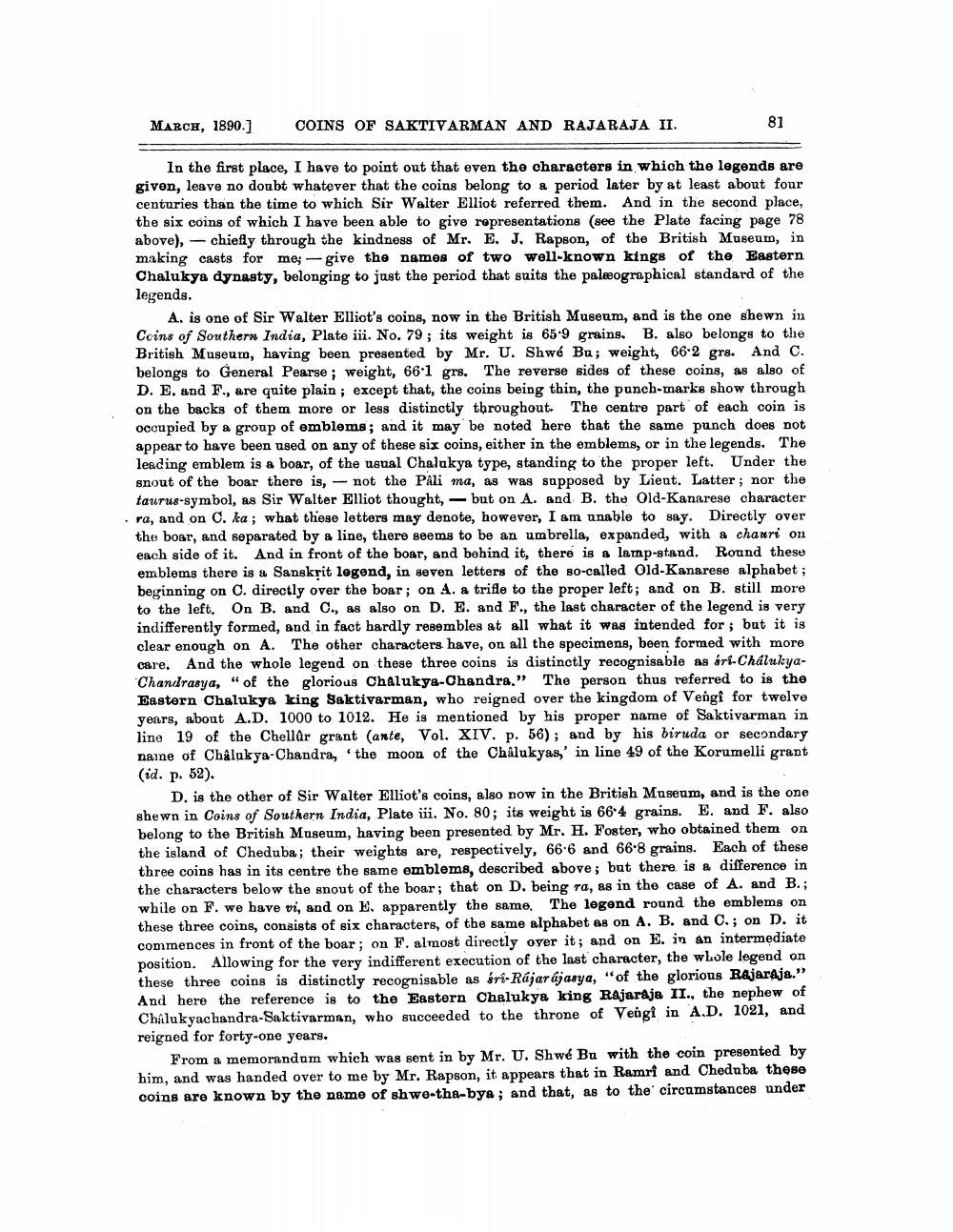________________
COINS OF SAKTIVARMAN AND RAJARAJA II.
81
MARCH, 1890.]
In the first place, I have to point out that even the characters in which the legends are given, leave no doubt whatever that the coins belong to a period later by at least about four centuries than the time to which Sir Walter Elliot referred them. And in the second place, the six coins of which I have been able to give representations (see the Plate facing page 78 above), chiefly through the kindness of Mr. E. J. Rapson, of the British Museum, in making casts for me; give the names of two well-known kings of the Eastern Chalukya dynasty, belonging to just the period that suits the paleographical standard of the legenda.
A. is one of Sir Walter Elliot's coins, now in the British Museum, and is the one shewn in Coins of Southern India, Plate iii. No. 79; its weight is 65-9 grains. B. also belongs to the British Museum, having been presented by Mr. U. Shwé Bu; weight, 66-2 grs. And C. belongs to General Pearse; weight, 661 grs. The reverse sides of these coins, as also of D. E. and F., are quite plain; except that, the coins being thin, the punch-marks show through on the backs of them more or less distinctly throughout. The centre part of each coin is occupied by a group of emblems; and it may be noted here that the same punch does not appear to have been used on any of these six coins, either in the emblems, or in the legends. The leading emblem is a boar, of the usual Chalukya type, standing to the proper left. Under the snout of the boar there is, not the Pâli ma, as was supposed by Lieut. Latter; nor the taurus-symbol, as Sir Walter Elliot thought, but on A. and B. the Old-Kanarese character ra, and on C. ka; what these letters may denote, however, I am unable to say. Directly over the boar, and separated by a line, there seems to be an umbrella, expanded, with a chauri on each side of it. And in front of the boar, and behind it, there is a lamp-stand. Round these emblems there is a Sanskrit legend, in seven letters of the so-called Old-Kanarese alphabet; beginning on C. directly over the boar; on A. a trifle to the proper left; and on B. still more to the left. On B. and C., as also on D. E. and F., the last character of the legend is very indifferently formed, and in fact hardly resembles at all what it was intended for; but it is clear enough on A. The other characters have, on all the specimens, been formed with more care. And the whole legend on these three coins is distinctly recognisable as śri-ChalukyaChandrasya, "of the glorious Chalukya-Chandra." The person thus referred to is the Eastern Chalukya king Saktivarman, who reigned over the kingdom of Vengî for twelve years, about A.D. 1000 to 1012. He is mentioned by his proper name of Saktivarman in line 19 of the Chellûr grant (ante, Vol. XIV. p. 56); and by his biruda or secondary name of Chalukya-Chandra, the moon of the Chalukyas,' in line 49 of the Korumelli grant (id. p. 52).
D. is the other of Sir Walter Elliot's coins, also now in the British Museum, and is the one shewn in Coins of Southern India, Plate iii. No. 80; its weight is 66-4 grains. E. and F. also belong to the British Museum, having been presented by Mr. H. Foster, who obtained them on the island of Cheduba; their weights are, respectively, 66-6 and 66-8 grains. Each of these three coins has in its centre the same emblems, described above; but there is a difference in the characters below the snout of the boar; that on D. being ra, as in the case of A. and B.; while on F. we have vi, and on E. apparently the same. The legend round the emblems on these three coins, consists of six characters, of the same alphabet as on A. B. and C.; on D. it commences in front of the boar; on F. almost directly over it; and on E. in an intermediate position. Allowing for the very indifferent execution of the last character, the whole legend on these three coins is distinctly recognisable as śri-Rajarajasya, "of the glorious Rajaraja." And here the reference is to the Eastern Chalukya king Rajaraja II., the nephew of Chalukyachandra-Saktivarman, who succeeded to the throne of Vengi in A.D. 1021, and reigned for forty-one years.
From a memorandum which was sent in by Mr. U. Shwé Bu with the coin presented by him, and was handed over to me by Mr. Rapson, it appears that in Ramri and Cheduba these coins are known by the name of shwe-tha-bya; and that, as to the circumstances under




